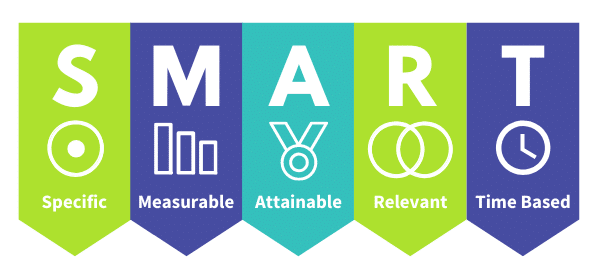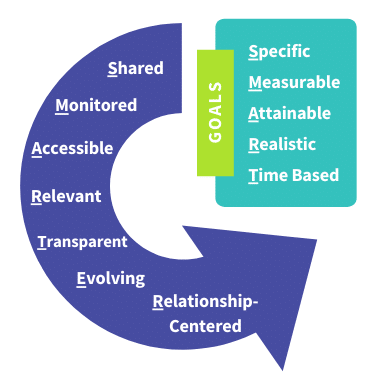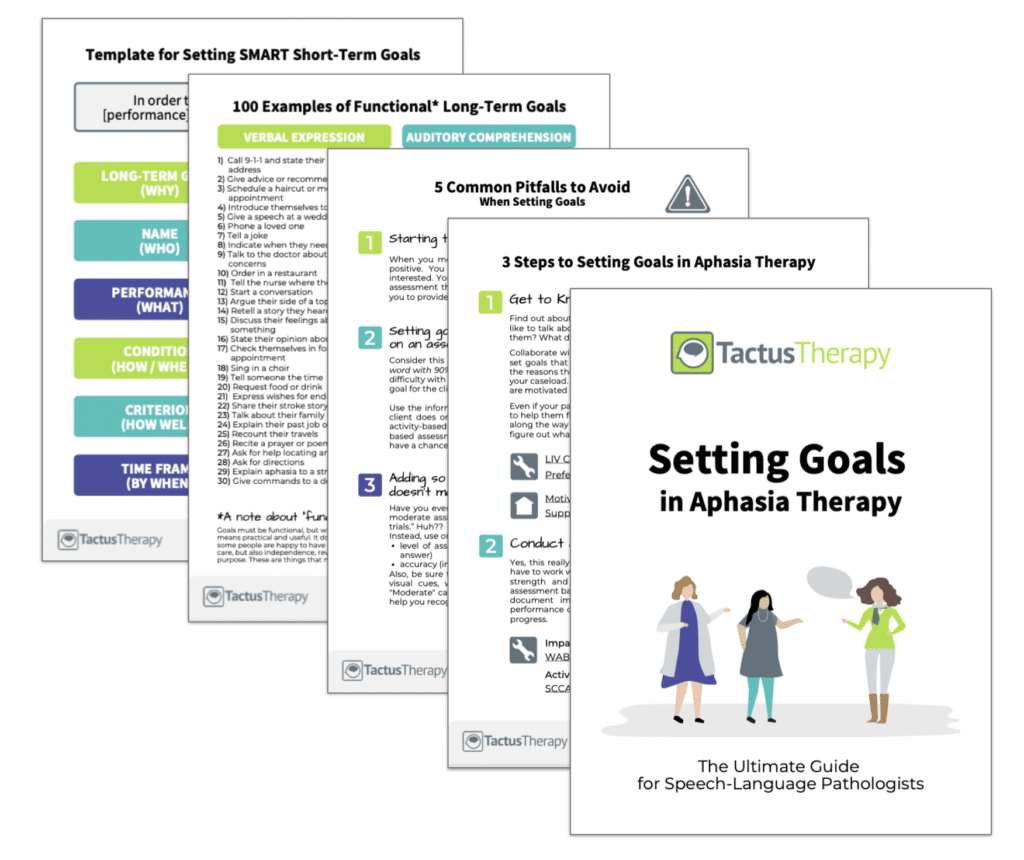It’s a Goal! Setting Patient-Centered Speech Therapy Goals for Aphasia Rehabilitation
7 min read
Goals are the basis for all speech and language therapy treatment. Without a clear goal or plan, therapy can appear confusing and irrelevant, leading to a lack of motivation and disengagement1. Often however, the process of setting speech therapy goals for aphasia can be much harder than it first appears.
Put simply, a goal is a shared agreement between the client and the therapist about the direction of therapy. Speech therapy goals for aphasia rehabilitation should always be set by the therapist in collaboration with the person with aphasia and the people who are important to them, such as family, caregivers, and close friends.

But my patient has aphasia! How do I include them in the goal-setting process?
Firstly, you need to describe what a goal is, and explain the goal-setting process to your patient and their family in an accessible way. It’s probably not a concept they are familiar with, so they need to understand what goals are all about before they can take part.
You may have already carried out your assessments and learned a great deal about your patient’s language profile. You should use this information to utilize their communicative strengths to help them take part in the process of setting goals. Make use of communication strategies, including written words, gestures, and visuals.
Talk to their family and friends (with permission), and use questionnaires or motivational interviewing to gain an idea of what they are interested in, as well as the specific situations in which their aphasia causes them problems. Create an aphasia-friendly questionnaire to give to your patient so they can have their say too! Supported conversation using Talking Mats or the Life Interests and Values cards can work really well here.
The bottom line is, be creative. Use your skills as an SLP to empower your patient and their family to have their say in their treatment. Once you’re all on the same page about the goals of therapy, your job will be much easier.
Download this comprehensive guide to setting goals
Download your FREE guide to learn how to set good speech therapy goals – and what not to do.
You’ll get:
- 3 Steps to Setting Goals
- 5 Common Pitfalls to Avoid
- 6-Part Template for Setting SMART Goals
- 100 Examples of Functional Goals
In addition to receiving your free download, you will also be added to our mailing list. You can unsubscribe at any time. Please make sure you read our Privacy Policy and Terms & Conditions.
What speech therapy goals for aphasia rehabilitation do people want to work on?
Unfortunately, there is no simple answer to this question. Aphasia affects everyone in different ways. An important part of the goal-setting process is trying to gain an understanding of the specific impact of aphasia on your patient. When goals are classified according to the World Health Organization’s ICF framework for health and disability, most people with aphasia place the highest value on treatments that increase their participation in daily life4.
In general, the aims of aphasia treatment as described by ASHA include:
- restoring lost language abilities
- strengthening intact communication skills
- compensating for impairments by teaching strategies and using AAC
- training caregivers to communicate more effectively
- facilitating generalization of skills to various contexts
- educating all involved about aphasia and the course of treatment
How these aims are incorporated into intervention, however, will very much depend on the individual needs and wishes of your patient, as well as your skills as a therapist. Many therapists focus only on the first aim, which can lead to early plateaus and unnecessary discharges from therapy. Try to include all areas in your goals to maximize the impact of your treatment.
So I have an idea of what my patient wants to achieve. How do I write my goal?
Speech therapy goals for aphasia usually have both long- and short-term elements. In a nutshell, the short-term goals are the steps your patient needs to take to reach their long-term goal.
A useful framework to use when writing goals is to make them SMART:
- Specific
- Measurable
- Attainable
- Relevant
- Time-Based

Be aware that goal setting is a dynamic process – goals will change over time as the skills and needs of your patient change. It is important to review goals regularly and update them when appropriate.
Take a look at this example. Can you identify each element of the SMART framework?
In order to have less frustrating conversations with her husband at home, Mrs. T. will use a circumlocution strategy to repair word-finding difficulties in structured conversations with 90% success within 3 weeks.
The first part of the goal is the long-term goal – the part that follows “In order to…”. This is WHY we’re working on the goal. The next part is WHO will perform the goal – Mrs. T. Then we see WHAT she will do (performance), WHERE she will do it (condition), and HOW WELL she will do it (criterion)3. Finally, we read by WHEN the goal will be achieved.
Learn the top 10 word-finding strategies you can use to reduce frustration in conversation, and check out the apps that will help you practice them in therapy.
Sometimes it’s the long-term goal that is written in the SMART goal format, with smaller steps to reach it.
Long-Term Goal
Mr. K will be able to write down key pieces of information from a telephone call to leave a written message for his wife that conveys the information with 90% accuracy within 6 weeks.
Short-Term Goals
- Mr. K will write 3-word phrases to dictation.
- Mr. K will identify 3 key pieces of information within a spoken message.
- Mr. K will write down phone numbers from dictation accurately.
- Mr. K’s confidence in this task will increase from a 2/5 to a 4/5 on a self-rating scale.
Use Number Therapy to practice saying, understanding, and writing phone numbers, dates, and times. Use Advanced Writing Therapy to practice writing phrases to dictation and taking phone messages.
Get the idea? Each of these goals should be shared with your patient, monitored by both of you, and should encourage the therapeutic relationship. This is how you set SMART goals in a SMARTER way.2

Is there anything else I need to be aware of when setting speech therapy goals for aphasia therapy?
Sometimes, your patient may struggle to think of a goal beyond simply “I want to be able to talk better.” If this is the case, you need to work on the specific and measurable aspects of the SMART framework and support your patient to think of particular situations in which they want to be able to communicate more effectively. You can then tailor therapy tasks around this relevant situation to make your therapy more focused and make measuring success a whole lot easier.
Use the time-based factor within a SMART goal carefully. It’s useful to have points at which you review your goals, but if your patient isn’t on target to reach their goal as quickly as was originally thought, they run the risk of becoming frustrated or unmotivated. If you are concerned your patient may not reach a goal within a given time frame, consider lowering the success rate (e.g. from 80% success to 50% success). If your patient is still motivated to continue to better their performance after the review period, you can always increase the success rate. Consider the attainable aspect of the SMART framework carefully to help you make this decision.
Pearson’s Law: “That which is measured improves. That which is measured and reported improves exponentially.” Tactus Therapy apps make it so easy to measure progress with built-in reports and data tracking. And scientific research shows that improvement follows!
Remember, goals are dynamic. They do not have to be fixed and may change with the patient’s needs in response to the environment or improving communication skills. If a goal is met before the review period, fantastic! If your patient decides that the goal is no longer a priority, that’s okay! Work with your patient to develop new goals that fit in with what they need at that time.
Finally, it’s easy to become bogged down in the detail, but try not to overthink goal setting in aphasia rehabilitation. Treat a goal like your therapy map – it will help to guide what you do within your sessions and ultimately help your patient do more of what they want to do in their life. A goal is the first step in the journey to success.
References
- Hersh, D., Sherratt, S., Howe, T., Worrall, L., Davidson, B. and Ferguson, A. (2012). An analysis of the ‘goals’ in aphasia rehabilitation. Aphasiology, 26(8), 971-984.
- Hersh, D., Worrall, L., Howe, T., Sherratt, S., & Davidson, B. (2012). SMARTER goal setting in aphasia rehabilitation. Aphasiology, 26(2), 220-233.
- Mager, Robert F. Preparing Instructional Objectives: A Critical Tool in the Development of Effective Instruction (1997).
- Worrall, L., Sherratt, S., Rogers, P., Howe, T., Hersh, D., Ferguson, A. and Davidson, B. (2011). What people with aphasia want: their goals according to the ICF. Aphasiology, 25(3), 309-322.



